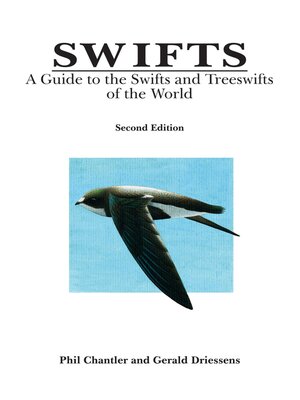Swifts
ebook ∣ A Guide to the Swifts and Treeswifts of the World · Helm Identification Guides
By Phil Chantler

Sign up to save your library
With an OverDrive account, you can save your favorite libraries for at-a-glance information about availability. Find out more about OverDrive accounts.
Find this title in Libby, the library reading app by OverDrive.



Search for a digital library with this title
Title found at these libraries:
| Library Name | Distance |
|---|---|
| Loading... |
Swifts pose some of the most difficult identification field identification problems and it is the aim of this guide to provide information that will help resolve many of these problems.
For the first time all 96 species of swifts and treeswifts are included in a single volume. Swifts are found throughout the world except in the polar regions; some, such as the Common Swift and the Chimney Swift, are common and widespread, but others are both elusive and scarce.
The 24 colour plates have been designed so that, wherever possible, species that can be confused are shown together. All species and, wherever relevant, all distinct plumage differences have been illustrated in flight, from above and below. The main field characteristics are highlighted in the accompanying caption text to facilitate the separation of species whose ranges overlap.
The comprehensive text has a strong emphasis on identification and distribution, but also includes information on habitat, voice, habits and breeding. The species' descriptions are very detailed, often describing features that are not easily visible in the field but which may contribute to the overall appearance of the bird. They are intended to be useful both in the field and in the hand. A range map accompanies each species account and many line drawings are included to illustrate specific features.
Phil Chantler and Gerald Driessens have between them observed a large number of the world's swifts and they have drawn extensively on this experience in producing this work. This text includes much unpublished data and the painstakingly-researched plates are based on field sketches and photographs wherever possible. This important book, which is the standard reference on the subject, will stimulate interest in these fascinating and challenging birds.
For the first time all 96 species of swifts and treeswifts are included in a single volume. Swifts are found throughout the world except in the polar regions; some, such as the Common Swift and the Chimney Swift, are common and widespread, but others are both elusive and scarce.
The 24 colour plates have been designed so that, wherever possible, species that can be confused are shown together. All species and, wherever relevant, all distinct plumage differences have been illustrated in flight, from above and below. The main field characteristics are highlighted in the accompanying caption text to facilitate the separation of species whose ranges overlap.
The comprehensive text has a strong emphasis on identification and distribution, but also includes information on habitat, voice, habits and breeding. The species' descriptions are very detailed, often describing features that are not easily visible in the field but which may contribute to the overall appearance of the bird. They are intended to be useful both in the field and in the hand. A range map accompanies each species account and many line drawings are included to illustrate specific features.
Phil Chantler and Gerald Driessens have between them observed a large number of the world's swifts and they have drawn extensively on this experience in producing this work. This text includes much unpublished data and the painstakingly-researched plates are based on field sketches and photographs wherever possible. This important book, which is the standard reference on the subject, will stimulate interest in these fascinating and challenging birds.







